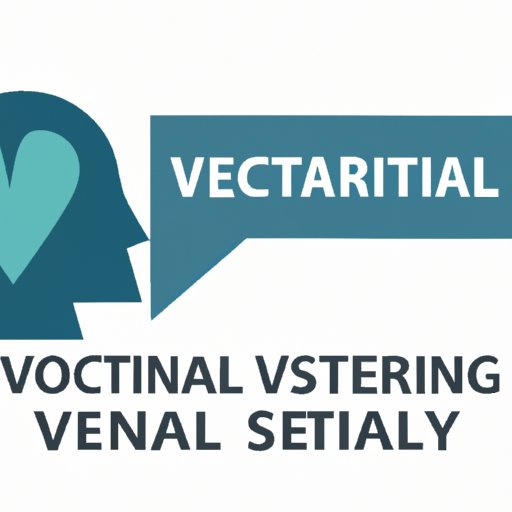Introduction
Eating disorders are serious mental health issues that can have devastating physical and psychological effects. While there is still much to learn about these conditions, it is important to understand the underlying causes, symptoms, and treatment options available. By educating yourself on the different types of eating disorders and developing healthy coping strategies, you may be able to reduce your risk of developing an eating disorder and seek help if needed.

A. Definition of Eating Disorders
Eating disorders involve extreme disturbances in eating behaviors and can involve both over-eating and under-eating. They can range from mild to severe and can affect people of all ages, genders, and backgrounds. According to the National Eating Disorders Association (NEDA), “Eating disorders are real, complex, and devastating conditions that can have serious consequences for health, productivity, and relationships.”
B. Overview of the Different Types of Eating Disorders
The most common types of eating disorders include anorexia nervosa, bulimia nervosa, binge eating disorder, and other specified feeding or eating disorders (OSFED). Anorexia nervosa is characterized by an intense fear of gaining weight and extreme restriction of food intake. Bulimia nervosa involves episodes of binge eating followed by purging behaviors such as vomiting or laxative use. Binge eating disorder involves recurrent episodes of overeating without purging behaviors. OSFED encompasses a range of disordered eating behaviors that do not meet the criteria for the other eating disorders.
Body
I. Explore the Underlying Causes of Eating Disorders
Eating disorders are complex mental health issues with a range of underlying causes. It is important to understand the biological, psychological, and societal factors that can contribute to the development of an eating disorder.
A. Biological Factors
Research suggests that genetics may play a role in the development of eating disorders. Studies have found that individuals with a family history of eating disorders are more likely to develop an eating disorder themselves. Additionally, changes in the brain chemistry associated with certain hormones and neurotransmitters have been linked to eating disorders.
B. Psychological Factors
Psychological factors such as low self-esteem, perfectionism, and difficulty regulating emotions can also contribute to the development of eating disorders. A study published in the journal Eating Behaviors found that individuals with eating disorders often struggle with feelings of shame, guilt, and anxiety related to their eating behaviors.
C. Societal Factors
Societal factors such as media images that glorify thinness and an emphasis on dieting can also contribute to the development of an eating disorder. According to a study published in the journal Pediatrics, exposure to media images of thin models and celebrities can increase body dissatisfaction and lead to unhealthy eating behaviors.
II. Understand the Physical and Psychological Symptoms of Eating Disorders
It is important to recognize the physical and psychological symptoms of eating disorders so that you can seek help if needed. Common physical symptoms of eating disorders include significant weight loss or gain, fatigue, dizziness, and electrolyte imbalances. Common psychological symptoms include preoccupation with food, distorted body image, and feelings of guilt or shame related to eating.

III. Educate Yourself on the Different Types of Eating Disorders
It is important to understand the different types of eating disorders so that you can recognize the signs and symptoms in yourself or others. Anorexia nervosa is characterized by extreme restriction of food intake and an intense fear of gaining weight. Bulimia nervosa involves episodes of binge eating followed by purging behaviors such as vomiting or laxative use. Binge eating disorder involves recurrent episodes of overeating without purging behaviors. OSFED encompasses a range of disordered eating behaviors that do not meet the criteria for the other eating disorders.
IV. Learn How to Recognize Signs of Disordered Eating in Yourself or Others
It is important to be aware of the warning signs and risk factors associated with disordered eating so that you can seek help if needed. Warning signs of disordered eating can include extreme dieting, skipping meals, preoccupation with food, and drastic changes in weight. Risk factors for disordered eating include personal or family history of eating disorders, dieting or restrictive eating, and pressure from peers or society to be thin.

V. Connect with a Mental Health Professional for Support and Treatment
If you or someone you know is struggling with an eating disorder, it is important to seek professional help. Treatment for eating disorders typically involves a combination of psychotherapy, nutritional counseling, and medication. Benefits of treatment can include improved physical and psychological health, better relationship with food and body, and increased self-confidence.
VI. Develop Healthy Coping Skills to Reduce Stress and Anxiety
In addition to seeking professional help, it is important to develop healthy coping strategies to reduce stress and anxiety. Identifying triggers that can lead to disordered eating behaviors can help you avoid them in the future. Relaxation techniques such as deep breathing and progressive muscle relaxation can also be helpful. Practicing mindfulness can help you stay present in the moment and respond to difficult emotions in a healthy way.

VII. Take Steps to Create a Healthier Relationship with Food and Your Body
Creating a healthier relationship with food and your body can be a challenging process, but it is possible. Developing healthy eating habits such as eating regular meals and snacks and avoiding restrictive diets can help. Incorporating regular exercise and movement into your routine can also be beneficial. Finally, seeking out support from family, friends, and professionals can help you on your journey to recovery.
Conclusion
Eating disorders are complex mental health issues with a range of underlying causes. This article explored the causes, symptoms, and treatment options available for those struggling with eating disorders, as well as tips on how to create a healthier relationship with food and your body. By understanding the underlying causes and recognizing the signs and symptoms, you can take steps to reduce your risk of developing an eating disorder and seek help if needed.
of Main Points
This article explored the causes, symptoms, and treatment options available for those struggling with eating disorders. It discussed the biological, psychological, and societal factors that can contribute to the development of an eating disorder and outlined warning signs and risk factors to be aware of. It also provided tips on how to develop healthy coping strategies and create a healthier relationship with food and your body.
B. Final Remarks
Eating disorders are serious mental health issues that can have devastating physical and psychological effects. It is important to educate yourself on the different types of eating disorders and recognize the warning signs and risk factors. By connecting with a mental health professional and developing healthy coping strategies, you may be able to reduce your risk of developing an eating disorder and seek help if needed.
(Note: Is this article not meeting your expectations? Do you have knowledge or insights to share? Unlock new opportunities and expand your reach by joining our authors team. Click Registration to join us and share your expertise with our readers.)
